A Guide to a Realistic Software Project Estimate

A realistic software project estimate is really just a forecast. It's your best guess at the time and resources you'll need to get a project over the finish line, based on everything you know right now. It means breaking the work down, digging into past data, and using proven techniques to guess at the effort involved, all while remembering it's a probability, not a promise.
The Agony and Ecstasy of Software Estimation
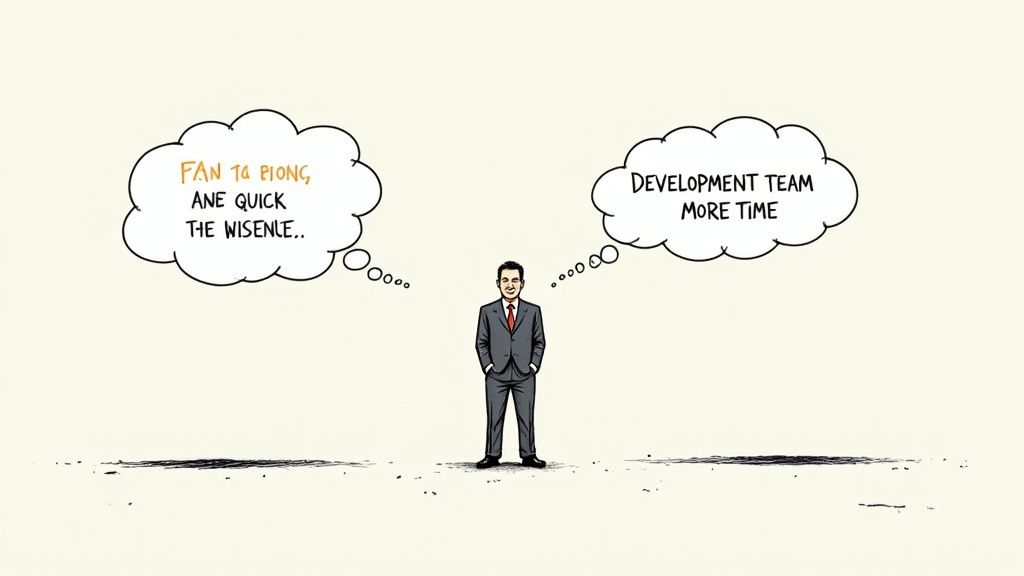
It's the question that kicks off that familiar dance between optimism and dread: "So, how long will this take?"
We've all been there. You feel caught between giving a number that makes a client happy and one that won't sentence your team to a month of sleepless nights. But that moment is also your first real chance to build trust.
I learned this the hard way on a project where our initial estimate was spectacularly wrong. We had built similar features before, so we confidently threw out a timeline based on past experience. What we didn't account for was a subtle change in a third party API we depended on. A "quick" integration task spiraled into a weeks long debugging nightmare, completely derailing our schedule and putting a serious strain on the client relationship.
The Human Element in Numbers
That experience taught me a crucial lesson. A software estimate isn't just a technical calculation; it's a profoundly human activity, riddled with cognitive biases and external pressures. We often fall victim to optimism bias, instinctively believing things will go smoother than they ever actually do.
The statistics back this up. Inaccurate estimates are a primary cause of project chaos. Industry benchmarks show that around 69% of projects blow past their original time or budget. Only a minority, about 31%, are actually delivered on time and on budget. This data, which you can dig into on QSM's blog about software project statistics, highlights a systemic challenge we all face.
An estimate is not a promise carved in stone. It is a probabilistic forecast—a statement of likelihood based on the information you have right now.
Shifting from Dread to Strategy
Viewing estimation this way changes everything. The goal isn't to find a single "correct" number anymore. It's about understanding the cone of uncertainty and having a strategic conversation about risks, assumptions, and priorities.
A solid estimate is the bedrock of a successful project.
- Trust with Stakeholders: It sets realistic expectations and shows you've done your homework.
- Healthy Team Culture: It protects your developers from the burnout that comes with impossible deadlines.
- Successful Delivery: It gives everyone a realistic roadmap for planning and execution.
This guide is about turning that initial moment of dread into a structured, confident process. We're going to move beyond guesswork and explore how to create a software project estimate that serves as a true foundation for success.
Breaking Down The Beast Before You Estimate
A software project estimate is only as good as your understanding of the work. You simply can't put a number on a vague idea. Before you even think about timelines or budgets, you have to transform a high level feature request into a map of tangible, measurable tasks.
It all starts with a simple but powerful shift in mindset. Stop just accepting feature requests and start acting like a detective. Your job is to uncover the hidden complexities and assumptions lurking just beneath the surface.
Beyond User Stories: The Work Breakdown Structure
User stories are great, but they often focus only on the happy path from a user's perspective. A Work Breakdown Structure (WBS) goes much, much deeper. It's a hierarchical deconstruction of the entire project, breaking down the total scope of work into smaller, more manageable pieces that can actually be estimated.
Think of it like this. "Build a user login feature" is a classic epic. A WBS would dismantle that into concrete tasks:
- Design the UI for the login and registration forms.
- Develop the front end components for input fields and buttons.
- Create the API endpoint for user authentication.
- Set up the database schema for storing user credentials securely.
- Implement password hashing and security protocols.
- Write unit and integration tests for the authentication flow.
Each of these items is far easier to wrap your head around and estimate than the original request. Getting to this level of detail means asking the right questions, even the ones that feel "stupid." I once spent a full day chasing a bug only to realize a stakeholder's definition of "real time" was completely different from ours. Ask everything.
The infographic below shows how a typical project's work is really distributed once you break it down.
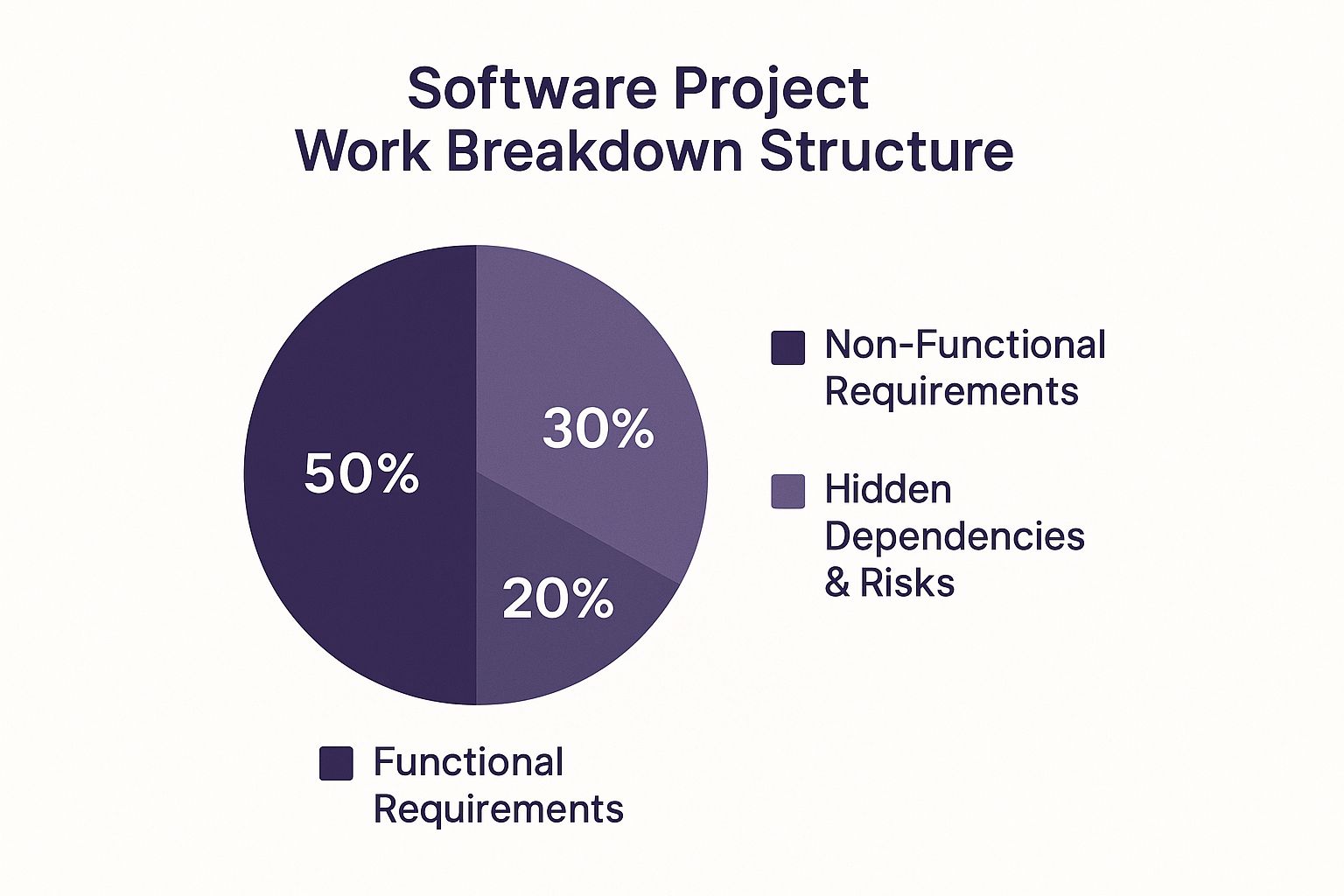
This visual highlights a critical point: a massive 50% of the work can be tied up in things that aren't direct user features, like performance tuning, security hardening, and risk mitigation.
Uncovering The Hidden Killers
The most dangerous parts of any project are the things you don't see coming. Before you can accurately estimate, it's crucial to understand and start defining project scope to make these invisible requirements visible.
Your goal is to turn "unknown unknowns" (risks you don't even know exist) into "known unknowns" (risks you can identify and plan for).
This means digging deep into non functional requirements, which are often the true budget killers. These aren't specific functions; they're the qualities of the system. You can explore a detailed guide to testing software requirements before you write a single line of code to learn more about this validation process.
Start by asking questions that force clarity on these issues:
- Performance: What are the expected response times under peak load? How many concurrent users must the system support?
- Security: What are the compliance requirements (like GDPR or HIPAA)? What are the potential threat vectors we need to defend against?
- Scalability: How will the system handle growth over the next two years? What is our strategy for adding more resources?
By breaking down the work and forcing these conversations early, you transform estimation from a wild guess into a structured, analytical process. This detailed map of tasks becomes the solid ground on which you can build a confident software project estimate.
Choosing Your Estimation Weapon Wisely
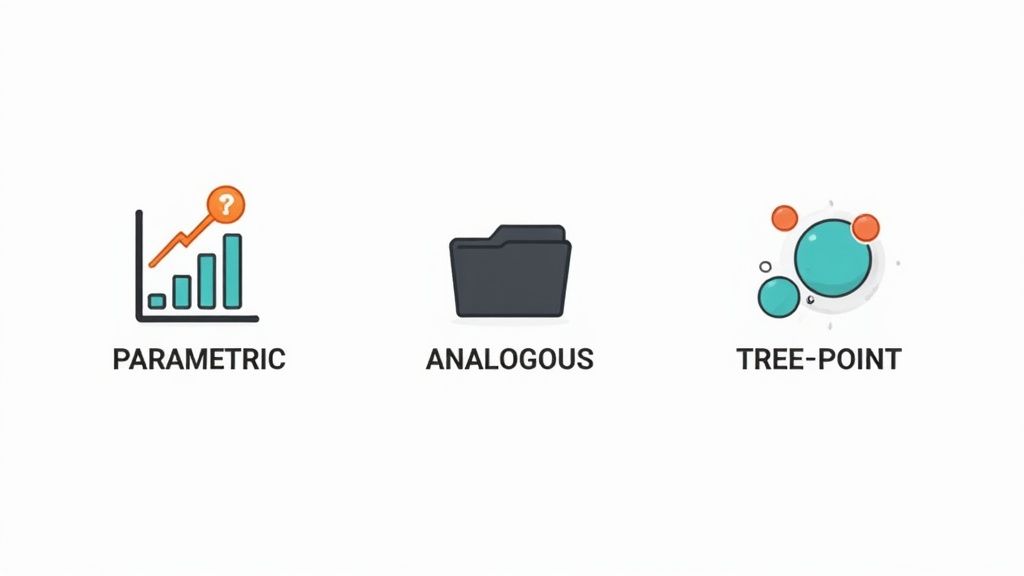
Let's get one thing straight: there is no silver bullet for estimation. Anyone who tells you their method is the only right way is probably selling something. The reality is much more nuanced. The best technique is the one that actually fits your team, the project's current stage, and what your stakeholders need to see.
Trying to apply a complex statistical model to a two week prototype is just burning time. On the flip side, relying on a gut feeling for a year long enterprise migration is a professional death wish. It's all about picking the right tool for the job.
I once worked on a massive project for a financial services client where our numbers were put under a microscope at every turn. It felt less like a project kickoff and more like a technical due diligence audit. We ended up using a hybrid approach, layering a few techniques to build a solid defense for our estimates. It was that rigor that finally won them over. You can get a feel for that kind of pressure by checking out what goes into a real technical due diligence checklist.
Parametric Estimation: Your Data Driven Ally
This sounds way more complicated than it is. Parametric Estimation is just a fancy way of saying you're using historical data to predict the future. You're essentially creating a formula based on your team's past performance.
This is where metrics like story points, function points, or even lines of code (if you must) become incredibly useful. By analyzing how long it took to deliver a certain number of "units" in previous projects, you can build a reliable model of your team's velocity. Studies have shown this can make your estimates up to 30% to 40% more accurate than just winging it.
For instance, if you know your team consistently knocks out about 25 story points per two week sprint, and a new epic is sized at 100 points, you've got a data backed starting point: roughly four sprints, or eight weeks.
Analogous Estimation: When History Rhymes
Sometimes you don't have perfect, granular data, but you've got a strong sense of déjà vu. Analogous Estimation is the art of looking at a new task and saying, "You know, this feels a lot like that feature we built last year."
It's less scientific and leans heavily on expert judgment, which makes it perfect for those early, high level estimates when you just need a ballpark number. I've used this on fast moving startup projects to quickly size up new ideas. We had a rule of thumb: a "simple CRUD screen" was about a week for a senior dev. That became our baseline for quick conversations.
The trick is to be brutally honest about the differences between the old project and the new one. Is the tech stack identical? Is the team's experience level the same? Every single difference adds a layer of uncertainty.
Three Point Estimation: Embracing Uncertainty
This one is my personal favorite because it forces everyone to have an honest conversation about risk. Instead of giving a single, concrete number that will be treated as gospel, you provide a range based on three distinct scenarios:
- Optimistic (O): The absolute best case scenario. No roadblocks, no unexpected bugs, just pure coding bliss.
- Most Likely (M): The realistic path. You account for the usual meetings, minor issues, and typical development friction.
- Pessimistic (P): The worst case scenario. Murphy's Law is in full effect, key people get sick, and a critical library is deprecated mid sprint.
From there, you can use a formula like the PERT analysis (O + 4M + P) / 6 to find a weighted average. This simple act shifts the entire conversation from "Will you hit this exact date?" to "What's our confidence level, and what can we do to mitigate the biggest risks?"
For seriously complex projects, this thinking opens the door to exploring advanced estimation techniques like Monte Carlo simulation, which can model thousands of potential outcomes to give you a true probabilistic forecast.
To make it easier to see how these stack up, I've put together a quick comparison table.
Comparison of Estimation Techniques
| Technique | Best For | Pros | Cons |
|---|---|---|---|
| Parametric | Mature teams with good historical data and repetitive tasks. | Data driven, objective, and often highly accurate. | Requires clean, consistent historical data to be effective. |
| Analogous | Early stage projects, quick ballpark figures, or when detailed requirements are unavailable. | Fast, simple, and leverages expert experience. | Highly subjective and only as good as the expert's memory and the chosen comparison project. |
| Three Point | Complex tasks or projects with high uncertainty and risk. | Acknowledges risk, forces a discussion about uncertainty, provides a realistic range. | Can be more time consuming to gather three separate estimates for each task. |
Choosing the right technique isn't a one time decision. You might start with an Analogous estimate for the initial pitch, move to Parametric for sprint planning, and use Three Point for a particularly risky R&D feature. The goal is to build confidence, not to pretend you have a crystal ball.
The Secret Sauce: Using Historical Data
Your past projects are a goldmine of estimation data, yet most teams let this treasure go to waste. It feels like a chore to track everything, so we finish a project, breathe a sigh of relief, and immediately dive into the next fire, leaving all that valuable insight behind.
But what if you could turn that history into your most powerful prediction tool? This isn't about creating complex spreadsheets or buying expensive software. It's about building a simple habit of capturing what actually happened, so your next software project estimate is grounded in reality, not just gut feelings.
Organizations that systematically analyze their historical data are the ones that get good at this. They build a learning culture where estimation techniques are constantly refined. This is what transforms estimation from a guessing game into a data driven science. You can learn more about how this data-driven approach improves estimation on buildops.com.
What Metrics Actually Matter?
Forget tracking every minute of every day. That's a recipe for burnout. Instead, focus on a few high impact metrics that tell a story about how your team works. You're looking for patterns, not perfection.
A few good places to start:
- Team Velocity: For teams using story points, this is your bread and butter. It's the average number of story points your team actually completes in a sprint. Simple, powerful, and a great measure of your team's delivery cadence.
- Cycle Time: This is the time it takes for a task to go from "In Progress" to "Done." I love this metric because it's fantastic at revealing bottlenecks. If your cycle time is high, it could mean tasks are getting stuck in code review, waiting on QA, or blocked by dependencies.
- Bug Rate: How many bugs or regressions pop up for every new feature you ship? A high bug rate is a signal that you probably need to buffer more time for QA and fixes in your future estimates. It's not a judgment, just a reality of your current process.
Building Your Estimation Knowledge Base
Let me share a quick story from a previous team. We felt like our estimates were always a shot in the dark, and it was causing a lot of frustration. To fix it, we created a dead simple "Estimation Knowledge Base" in our internal wiki. No fancy tools, just a shared page.
After each major feature or project, we'd spend just 30 minutes documenting three things:
- The Original Estimate: What did we think it would take? (e.g., 40 story points, 3 weeks).
- The Actual Outcome: What did it really take? (e.g., 55 story points, 5 weeks).
- The "Why": What caused the difference? Was it a surprise third party API change? Did we completely underestimate the complexity of the UI animations?
Over a few months, this simple document became our secret weapon. Before starting a new project, we'd check the knowledge base. "Oh, this involves that tricky payment gateway again. Last time, that added an extra week. Let's account for that from the start."
This isn't about blaming anyone for being "wrong." It's about building a collective memory for the team. It naturally accounts for nuances like team changes or a new tech stack because you can see how those factors impacted past projects.
This simple habit turns every project—successful or delayed—into a lesson that makes the next software project estimate that much sharper.
Communicating Estimates and Managing Expectations
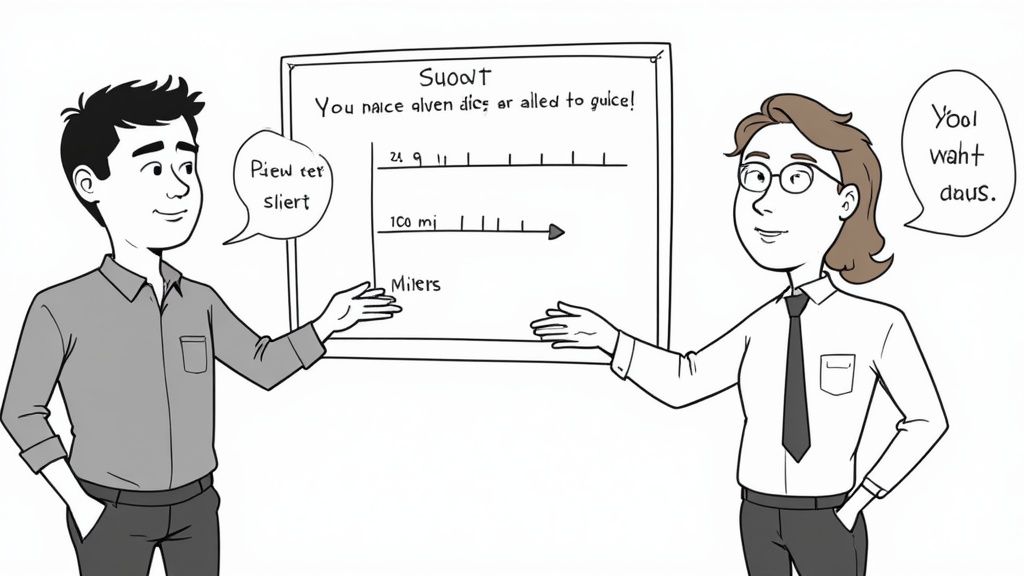
Creating the software project estimate is only half the battle. The other half—the one that really defines success—is actually presenting it. This is where your technical work slams into human psychology, and it's a moment you absolutely have to get right.
An estimate isn't a promise carved in stone. It's a probabilistic forecast, a statement of likelihood based on the information you have at that exact moment. Your real job is to shift the conversation from a demand for a single, unchangeable date to a collaborative discussion about risk and probability.
I've seen perfectly good estimates lead to project disasters simply because they were communicated poorly. A number without context is just a target for blame when things inevitably go sideways.
Frame the Conversation Around Ranges
The single most effective technique I've learned for managing expectations is to stop giving single numbers. Period. Always present your estimate as a range, ideally tied to a confidence level. This immediately changes the dynamic of the conversation.
Instead of saying, "This will take three months," try reframing it.
A much better approach is, "Based on our current understanding, we are 80% confident this will take between 10 and 14 weeks."
This phrasing accomplishes several critical things all at once:
- It acknowledges uncertainty: You're being upfront that the future isn't 100% predictable.
- It creates a buffer: The range naturally includes contingency without you having to say you're adding "padding."
- It invites the right questions: The immediate follow up is no longer "Why so long?" but "What are the risks that push us toward 14 weeks?"
Make Your Assumptions Crystal Clear
Every single estimate is built on a foundation of assumptions. If those assumptions turn out to be wrong, the whole estimate will crumble. You have to state them upfront, clearly and without apology. This isn't about making excuses; it's about creating a shared understanding of the project's reality.
Your list of assumptions is also your list of risks. When you say, "We assume the third party API will be stable," you are also saying, "If that API is unstable, our timeline is at risk."
Present these assumptions as part of the estimate itself. Treat them as a checklist for discussion with your stakeholders. This simple act turns them from passive recipients of a number into active partners in managing the project's risk.
This is a foundational mindset, especially for founders navigating the chaos of the early stages. For a deeper dive into this, it's worth exploring these essential things to know before starting a startup.
By presenting a range and clearly outlining your assumptions, you transform a potentially confrontational meeting into a strategic planning session. The goal shifts from defending a date to working together to navigate the path forward.
What to Remember for Your Next Estimate
Alright, let's bring it all home. Think of this as the cheat sheet you tape to your monitor before your next big estimation meeting. This isn't just a process; it's a mindset shift. We're moving estimation from a dreaded chore to a strategic tool that builds trust and sets projects up for success from day one.
Here are the core ideas to internalize:
- Break It Down. Then Break It Down Again. An estimate is completely useless if you don't have a deep, granular understanding of the work. Deconstruct every single feature into small, tangible tasks. And don't forget to aggressively hunt for those sneaky non functional requirements—they'll bite you later if you don't.
- Pick the Right Tool for the Job. Don't fall into the trap of using a single estimation method for everything. Is it a quick ballpark figure you need? Use Analogous Estimation. Need a more data driven plan for a well understood project? Parametric is your friend. Facing a mountain of uncertainty? Three Point Estimation will help you navigate it.
A software project estimate is not a commitment carved in stone. It's a transparent forecast based on what you know right now, designed to kickstart a strategic conversation about risk, value, and trade offs.
- Your Project History Is a Goldmine. Seriously, don't let that data gather digital dust. Tracking simple metrics like team velocity and cycle time isn't busywork; it's building an internal knowledge base that makes every future estimate sharper and more defensible.
- Talk in Ranges, Not Rigid Dates. This is a huge one. Always, always present your estimate as a confidence range (e.g., "We're looking at 10 to 14 weeks"). This simple change reframes the entire conversation around probability and risk, moving it away from impossible to keep promises. And make sure you clearly state every assumption you made to arrive at that range.
A Few Common Questions About Project Estimation
Let's tackle some of the questions that always seem to pop up whenever we talk about the art and science of a good software project estimate.
What's the Best Estimation Tool Out There?
Honestly, the best tool is usually the simplest one that gets the job done. I've seen teams sink tons of time and money into complex, dedicated estimation apps, and it rarely moves the needle.
In my experience, a combination of two things consistently works best. A basic spreadsheet is perfect for tracking your historical data—what you estimated vs. what actually happened. Then, a solid project management platform like Jira or Asana is all you need for handling the day to day work. The real magic is in refining your process, not just adding another piece of software to the stack.
How Do You Estimate a Project with Brand New Technology?
Ah, the classic. You're staring into the unknown, and the business wants a hard number. The key here is to realize you aren't estimating the final implementation; you're estimating the investigation. This is where a few specific agile techniques become your best friends.
- Spike Stories: Carve out a specific, time boxed task purely for research and prototyping. The only deliverable here isn't code—it's knowledge.
- Timeboxing: Put a hard cap on the initial research phase. For example, give the team three days to explore the new tech and come back with a demo or a report on what they learned. This prevents a research task from turning into an endless rabbit hole.
- Three Point Estimation: This method is tailor made for high uncertainty. It forces a conversation about the best case, worst case, and most likely scenarios, which is absolutely essential when you're dealing with so many unknowns.
How Often Should We Re-Estimate a Project?
Estimation is not a one and done event you perform at kickoff and then frame on the wall. It's a continuous process of refinement. It has to be.
For agile projects, this happens pretty organically. Estimates for upcoming work are constantly being discussed and refined every single sprint. It's built right into the rhythm of the work.
For longer, more traditional waterfall style projects, you should absolutely re evaluate the master estimate at key milestones. More importantly, you have to trigger a re estimation session whenever significant new information comes to light or a major scope change gets introduced. This fosters a culture of continuous planning instead of blindly sticking to a plan that everyone knows is already outdated.
Feeling the pressure to deliver accurate estimates for your next project? Kuldeep Pisda provides expert consulting to help early stage startups strengthen their technical foundations and deliver robust, scalable systems with confidence. Let's build something great together. Learn more at https://kdpisda.in.
Subscribe to our newsletter.
Become a subscriber receive the latest updates in your inbox.


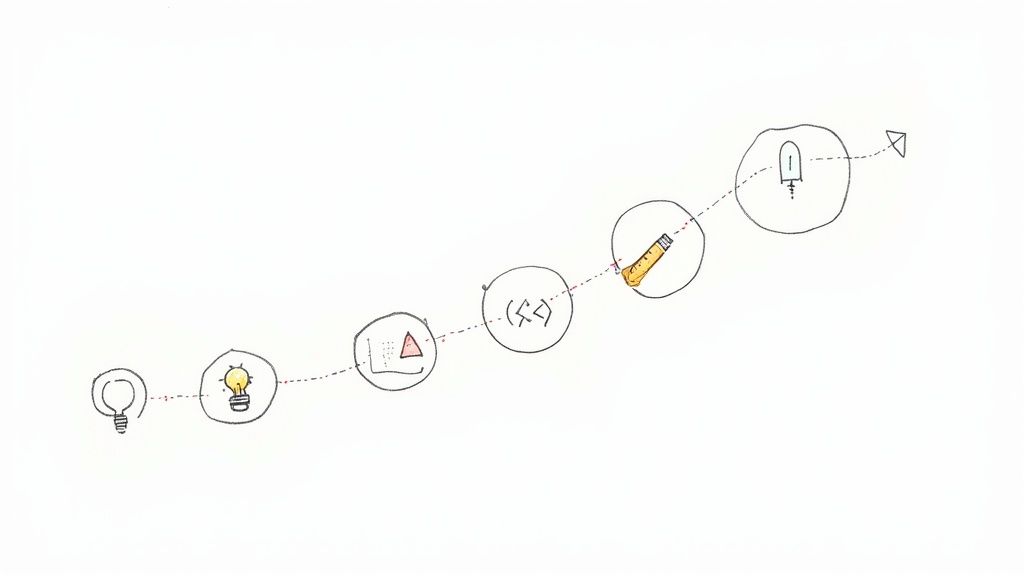
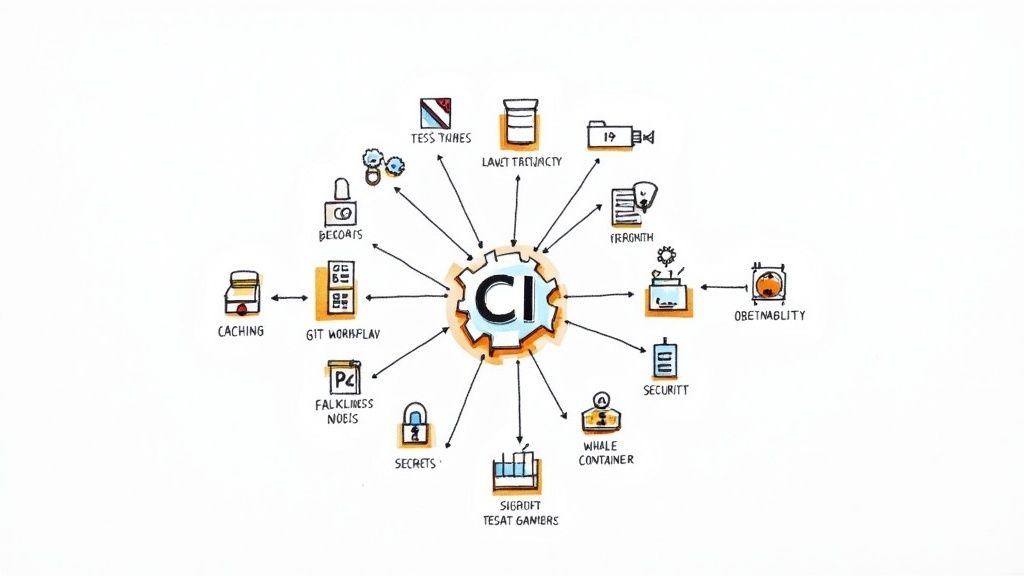



Member discussion